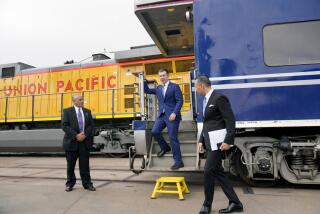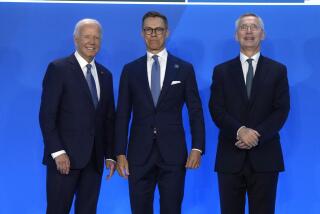Coast Guard Revamp
- Share via
Northrop Grumman Corp. and Lockheed Martin Corp. on Tuesday won the Coast Guard’s largest-ever contract--worth a potential $17 billion over 30 years--to replace and upgrade aging ships, aircraft and communication systems.
The fiercely contested contract, considered big even by today’s defense industry standards, calls for Northrop and Lockheed to help modernize a service that operates a fleet of ships and planes that is among the oldest in the world.
The program calls for the construction of 91 ships, 35 airplanes, 34 helicopters and 76 unmanned surveillance planes as well as the upgrading of 49 cutters and 93 helicopters. The ships and aircraft would be used to patrol the seas more than 50 miles offshore, hence its name, Operation Deepwater.
“It’s a tremendous win,” Northrop President Ronald Sugar said Tuesday. “We’re essentially recapitalizing one of the largest navies in the world.”
While a significant boon to the Northrop-Lockheed team, the contract also represents a major milestone for the Coast Guard.
The service has been struggling to meet its multifaceted mission that includes stopping illegal fishing, nabbing smugglers and making rescues at sea. And in the aftermath of the Sept. 11 terrorist attacks, the Coast Guard’s role has been expanded to include the hunt for terrorists.
Although the Coast Guard’s motto is Semper Paratus, Latin for “always ready,” the agency has had difficulty operating and maintaining its aging fleet, which is based mostly on 1960s technology and hull design. Most of the ships were built between 1964 and 1972--some even date to World War II. They rely on outdated radar and communication systems.
In an interview last year with The Times, Capt. Richard Kelly, a 29-year Coast Guard veteran, described the Coast Guard’s ships and planes as essentially “blind, deaf and dumb.” Its fastest cutters have a top speed of just under 30 knots, for instance, while speedboats used by drug smugglers zip across the water at more than twice that speed. Additionally, coast guardsmen must rely almost exclusively on the human eye to locate vessels in distress.
“What a grand day for the Coast Guard,” said Rear Adm. Patrick Stillman, executive officer for the Deepwater program, as he announced the contract winners Tuesday. “It is fundamental to changing the capability of maritime safety needs of this nation.”
To upgrade its fleet, the Coast Guard solicited proposals from some of the nation’s largest defense contractors in a competition that lasted four years. Eventually, the competition was narrowed to three teams--led by Northrop-Lockheed, Boeing Co. and Science Applications International Corp.
But in March, the Coast Guard told Boeing and SAIC, which was aligned with Raytheon Corp. and Manitowoc Co., that their proposals failed to meet specifications, effectively leaving the Northrop-Lockheed team as the lone remaining bidder for the contract.
Tuesday’s announcement made clear the massive size of Operation Deepwater. Analysts said the program would provide a much-needed boost to the nation’s few remaining shipyards and aircraft makers, industries that had been languishing under tightened Pentagon budgets and increased competition from foreign companies.
Northrop said that more than 100 companies in 32 states would be involved in the program in some way.
The contract award was announced after the close of the stock market. In New York Stock Exchange trading, Century City-based Northrop closed at $124, down $4.35, and Bethesda, Md.-based Lockheed fell $1.65 to $67.85 on a day that saw most defense stocks decline.
Under the terms of the contract, Northrop will design and build the new cutters at its Pascagoula, Miss., shipyard.
Lockheed will be responsible for developing the command, control and communication systems for the program as well as procuring the airplanes, helicopters and unmanned aircraft. The first new ships are scheduled to be delivered in 2006 or 2007, the Coast Guard said.
To keep costs down, the Coast Guard wants Northrop and Lockheed to mostly consider off-the-shelf equipment and technology in designing the system rather than develop new ones.
Satellite-based communications are expected to make up the backbone of the integrated system, which eventually could include purchasing military-type aircraft such as the new V-22 tilt-rotor that takes off, hovers and lands like a helicopter and flies like a fixed-wing aircraft.
The initial five-year contract is worth $290 million in the first year and $500 million in each of the four remaining years, with options for renewal in five-year blocks, the Coast Guard said.
In all, the Coast Guard anticipates eventually spending $11 billion for equipment and $5.9 billion for operation, maintenance and other related costs.
More to Read
Inside the business of entertainment
The Wide Shot brings you news, analysis and insights on everything from streaming wars to production — and what it all means for the future.
You may occasionally receive promotional content from the Los Angeles Times.










